Drag Pack Dodge Challenger
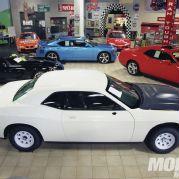
The Stone White Drag Pak cars are based on the 2010 Dodge Challenger SRT8 and in Stock Eliminator configuration, they’re almost 1,000 pounds lighter than the street car. Imagine if the street SRT8 weighed just 3,200 pounds! To help pare that weight and make it more race-ready, the package includes a “composite lift-off hood with functional scoop, Dodge Viper-style front seats, polycarbonate door windows, a light-weight cooling module with electric fan, manual rack-and-pinion steering, a special cable-operated deck-lid release, special light-weight front-brake assemblies and special cable-operated throttle linkage and pedal assembly.”
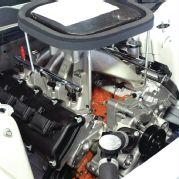
Though 2009 Drag Paks were ostensibly offered with your choice of a 275hp360 small-block (PN P5MOPP197), 305hp 5.7 Hemi (PN P5MOPP190) or 390hp 6.1 Hemi (PN P5MOPP189), the 2010 Drag Pak supplement sheet lists all of these engines plus a new 375hp 6.4 liter Hemi (PN P5MOPP794). However, a quick chat with Dave Hakim (one of the Drag Pak “chefs” during his tenure at Mopar Performance), confirms that the vast majority of 2009 and 2010 Drag Paks are equipped with the 6.1-liter Hemi shown here. Despite the 12.6:1 compression ratio and hot .584/.552 lift hydraulic roller cam, the NHRA rates the 6.1 Hemi at 390 hp (385 with manual transmission). Real world output is a tad higher.

Someone’s finger points to the Drag Pak’s semi-finished roof panel joints. On regular production Challengers, a body colored plastic strip fills this gap.
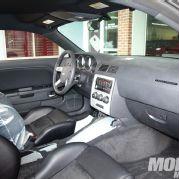
No Bostrum A100 van seats here, Drag Paks feature two driver-side Viper bucket seats. The stock Challenger rear seat, hand brake assembly and center console are deleted. Roush enlarges the transmission tunnel to accommodate anything from a 727 TorqueFlite to a Jerico, but it’s up to the purchaser to cut a shift handle access hole to suit his specific needs. The circular heater and A/C controls and dash outlets are dummies since the HVAC system is omitted to shave pounds.
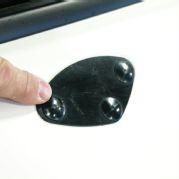
Just as the 1968 Hemi A-Bodies featured rectangular metal mirror delete plugs on the driver side door, 2010 DragPaks utilize triangular plastic patches secured by a trio of push-in buttons. They cover the holes left by the elimination of the standard Challenger dual rear view mirror assemblies.
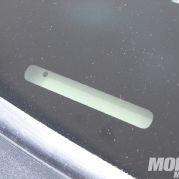
The usual VIN spot on the dash surface is vacant. This makes it impossible to register a Drag Pak for legal road use. Remember, Dodge hasn’t certified the Drag Pak for federal crash worthiness, fuel economy, or emissions compliance and doesn’t intend to do so. These are dragstrip-only machines.
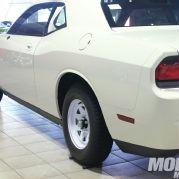
Dom says he was “pleasantly surprised” by the Drag Pak’s fit, finish, and paintwork. The cars are partially assembled at Chrysler’s Brampton, Ontario plant then shipped to Roush Industries in Livonia, MI for further completion. The standard R/T trunk spoiler is not included on Drag Paks but some cars have been delivered with trunk lids sporting the pre-drilled mounting holes. The trunk lid on Drag Pak 2010003 is a base Challenger V-6 stamping, so it lacks the spoiler mounting holes. Since ’09 and ’10 Drag Paks are delivered minus fuel tanks, the hinged fuel filler door opens into the void of the trunk compartment.
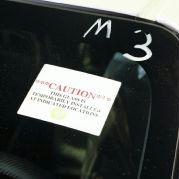
The windshield and backlite are standard issue Mopar safety glass but are temporarily installed for shipping. This allows easy removal for roll cage fabrication. Drag Paks are delivered via enclosed trailers to keep the semi-bonded glass from blowing out during transportation. Both glass panels are marked with yellow dots indicating the location of small adhesive dabs. The rear side windows are also production-grade Mopar shatterproof glass.
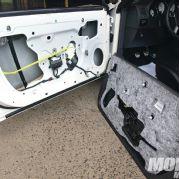
“When he first heard rumors of the new Dodge Challenger Drag Pak, Dom Papa knew he had to add one to the collection. Though he missed out on the 2009 production run, he was among the first in line for a 2010 model and got serial number three of the 50 to be built. Dom plans to keep it as-is rather than building it out and going racing. So let’s take a day-one look at the third 2010 LC22R Drag Pak Challenger ever built.” Steve Magnante
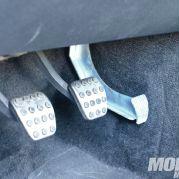
Dodge Challenger Drag Paks use a specific regulator unit which bears a sticker that reads: Challenger Drag Pkg. Car Door Module and displays part number P5MOPP319. Not visible are the marks left inside the door by the hand saw used to remove the adhesive-bonded inner door side impact brace tubes. This work was performed at Roush. Note the empty door speaker clearance hole. In true factory drag car tradition, these cars are strictly radio delete. Unlike the 2009 Challenger Drag Paks (which shipped with an empty manual or automatic transmission case), 2010 Drag Pak Challengers are shipped without a transmission. The trio of lightweight pedals and the installation of a clutch slave cylinder identify number 2010003 as being intended for use with a manual transmission. 2010 Drag Paks ordered for competition in automatic drag classes do not have a clutch pedal and employ a wider brake pedal pad.
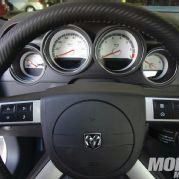
Though some 2009 Drag Paks feature the 160-mph SRT8 speedometer, 2010 models use the stock Challenger 140-mph speedometer. None of the gauges function, and the steering wheel air bag (and all others) is deleted. Other deletions include thumb button stereo and cruise control stalk functions and the elimination of the column mounted turn signal indicator/windshield wiper switch assembly. At Roush, a separate Mopar Performance switch panel is installed in the place normally reserved for the stereo system.
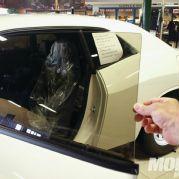
With a 3,200-pound shipping weight, the Drag Pak weighs about 1,000 pounds less than a standard production Challenger R/T. To save weight, the standard door glass is replaced with 3/16 thick clear poly-carbonate plastic replicas. Supplied by Shields, they’re treated with Supercoat to resist scratches. Contrary to reports stating the Drag Paks are delivered with the windows in the retracted position, Papa’s car was delivered with both windows fully raised. Previous ’65 and ’68 Race Hemi package cars used breakage-prone Chemcor lightweight door glass.
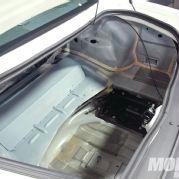
While previous 1965 Coronet and 1968 Dart Race Hemi package cars required trunk-mount battery conversion kits, happily every new V-6, R/T, and SRT8 Challenger comes factory stock with a trunk mounted battery. No Drag Pak modifications are made to the stock tray though it’s certainly too small for a vintage 100-pound Mopar Super Stock battery. This angle offers another view of the Roush-fabbed metal differential cover panel. The Brampton body plant intentionally minimized the application of seam sealer and sound insulation padding to reduce mass and mess during welding.
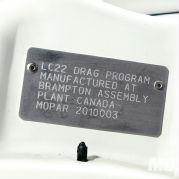
Riveted to the passenger side strut tower, every 2009 and 2010 Drag Pak features a laser-etched aluminum I.D. tag like this. Cars built in 2009 have serial numbers starting with 2009. This example is the third 2010 unit built and accordingly bears serial number 2010003.
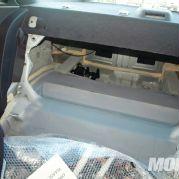
The rear seat area is intentionally arranged to ease rollcage fabrication. The rectangular cover panel over the rear axle hump is not OE Challenger architecture. Rather, the formed metal cover is provided to allow clearance for a Dana 60 live axle. Temporary rivets secure the cover for easy removal during race chassis fabrication. The open area between the interior and trunk compartment must be closed for NHRA compliance. All transmission tunnel, floor pan, and other chassis modifications to the unibody are performed by Roush personnel in Livonia, Michigan
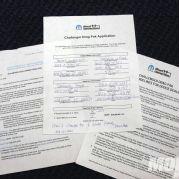
On February 9, 2010, Mopar formally announced the 2010 Drag Pak program to dealerships. On the top is Dom Papa’s hand written application form that he returned to Mopar via FAX. Five months later, in July 2010, Dom was notified that his car had been completed and was ready for delivery. Dom says; “Even though it isn’t a running, driving car like a new Dodge Challenger SRT8, this was a chance to get a real-deal factory drag car and add it to our collection. We’re thrilled we got serial number three.”
While great effort is made to ensure the accuracy of the information on this site, errors can occur. Please verify all pricing and installed equipment information with a customer service representative. This is easily done by calling us or visiting us at the dealership.
Customer may not qualify for ALL Rebates shown. Some rebates are stackable and others can and cannot be combined. See Dealer For Complete Details.
We improve our products and advertising by using Microsoft Clarity to see how you use our website. By using our site, you agree that we and Microsoft can collect and use this data. Our privacy statement has more details.